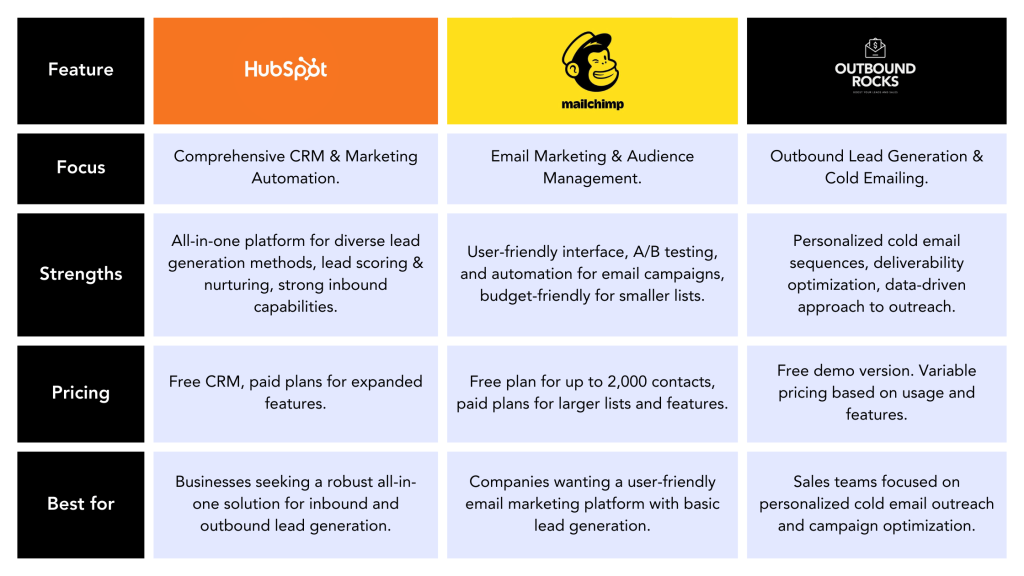In the world of email marketing, there are two main types of leads: inbound and outbound.
Understanding the difference between them can help you create an effective email marketing strategy for your business.
Read on to discover the pros and cons of inbound and outbound email leads, and how to use both for maximum impact and increased customer conversions.
Before we explore the pros and cons, let’s review the basics of inbound and outbound lead strategies.
TABLA DE CONTENIDOS
– Inbound Email Leads
– Outbound Email Leads
– Inbound and Outbound Key Differences
– Tips for Targeted Email Sales Strategies
– Tools and Platforms for Lead Generation
– Conclusions
What are Inbound Email Leads?
Inbound email leads are generated when a potential customer contacts your business via email.
This can happen in a variety of ways, including filling out a contact form on your website, signing up for your email list, or responding to a blog or social media post.
Inbound email leads tend to be more qualified because the prospect has actively expressed interest in your business.
What are Outbound Email Leads?
Outbound email leads are generated when your company initiates contact with prospects via email, such as through cold email campaigns, purchased lists, or other outreach efforts.
These leads often require a longer sales process because the prospect hasn’t previously shown interest. However, both inbound and outbound email leads are valuable to your business.
While inbound leads tend to have a higher conversion rate, outbound leads can reach a wider audience and generate a larger pool of leads overall.
Inbound and Outbound Key Differences
| Feature | Outbound Lead Strategy | Inbound Lead Strategy |
| Lead Initiation | You reach out to potential customers first. | Potential customers reach out to you first. |
| Lead Qualification | Lower initial qualification, requires nurturing to assess interest. | Higher initial qualification, indicates active interest in your product/service. |
| Sales Cycle | Typically longer sales cycle, needs relationship building and trust. | Typically shorter sales cycle, focuses on converting existing interest. |
| Cost per Lead | Can be lower through automation and purchased lists. | Can be higher due to content creation and marketing efforts. |
| Control | You control the initial message and timing. | Limited control over when and how leads contact you. |
| Personalization | Requires targeted outreach and personalization for higher engagement. | Content and offers can be pre-tailored to attract relevant leads. |
| Lead Source Examples | Cold email campaigns, purchased email lists, social media outreach, etc. | Website forms, blog comments, email subscriptions, SEO traffic, etc. |
| Metrics to Track | Open rates, click-through rates, conversion rates, sales cycle length, etc. | Website traffic, lead conversion rates, customer acquisition cost, lead quality, etc. |
Tips for Targeted Email Sales Strategies
1. Personalization and Segmentation
Segment your audience based on demographics, interests, and purchase history. Use their names, address past interactions, and tailor offers to their specific needs.
Imagine a prospect named Sarah who recently viewed your fitness tracker: “Hi Sarah, we noticed you were checking out our fitness trackers! Remember, you can also track your sleep cycles with the Pro model!“
Use software that dynamically inserts personalized elements such as location, product recommendations, or countdown timers for limited-time offers.
2. Building Trust and Value
Informative content establishes you as an expert and builds trust. Share industry insights, customer success stories, or helpful tips related to your products.
Consider Sarah again: “Want to smash your fitness goals? Check out our blog post on 5 workouts for busy schedules!“
Focus on sending targeted campaigns with high-quality content instead of bombarding customers with irrelevant emails every day. And remember to provide value at every touch point.
Calls to Action that Drive Conversions
Use strong action verbs such as “Start Free Trial,” “Shop Now,” or “Download Guide”. Make sure the CTA copy is relevant to the content of the email and the desired action.
Experiment with button colors, locations, and text to see what resonates best with your audience. For Sarah, you might test “Get Your Personalized Fitness Plan” versus “Unlock Your Fitness Potential“.
A well-timed follow-up email reminds users who didn’t engage with the initial CTA. Offer an incentive or provide additional information to nudge them toward conversion. For Sarah, you might try: “Your offer expires in 2 days. Buy now and get an extra discount.“
By mastering these elements, you can transform your email sales strategy from generic blasts to targeted communications that build trust, deliver value, and ultimately drive conversions.
Tools and Platforms for Lead Generation
a) Hubspot
A comprehensive CRM and marketing automation platform with a wide range of capabilities for inbound and outbound lead generation. Key features:
- Forms, landing pages, email marketing, social media management, lead scoring, and nurturing.
- Free CRM with paid plans for advanced features.
- Especially strong for inbound lead generation and nurturing
b) Mailchimp
A popular email marketing platform with capabilities for lead generation and audience management. Key features:
- Email list building, segmentation, automation, A/B testing, and reporting.
- Free plan for up to 2,000 contacts with paid plans for larger lists and advanced features.
- User-friendly interface and integration with various apps.
3. Outbound Rocks
Specialized tool for outbound lead generation, focusing on cold email campaigns and personalization. Key features:
- Email personalization, automated sequences, email deliverability optimization, and tracking.
- Emphasis on cold outreach and personalized messaging.
- Pricing varies based on usage and features.
Next, we provide an overview to help you choose the right tool. By effectively using the right tools, you can create a robust lead generation strategy, reach more prospects, and ultimately drive business growth.

Conclusions
The key is to find the right balance between inbound and outbound email marketing and use targeted, personalized emails to convert leads into customers.
To find out how to build a successful and targeted outbound lead strategy, visit outboundrocks.com and try our demo for free.